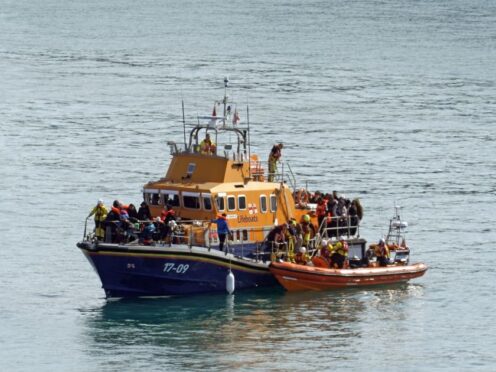More than 5,000 migrants have crossed the English Channel this year, with nearly 800 making the journey over the Easter bank holiday weekend, according to the latest figures.
A total of 791 migrants made the journey on Saturday March 30 and Sunday March 31, according to provisional figures from the Home Office.
Some 349 crossed on Saturday, with a further 442 spotted on Sunday.
This takes the total number of people making the journey this year to 5,435.
Before Saturday’s crossings, 2024 had already see a record high in the number of people making the journey in the first three months of a year.
The previous record high figure for January to March was 4,548 in 2022, with 3,793 arrivals in the first quarter of last year.
Stopping the boats was one of Rishi Sunak’s five pledges to the electorate ahead of an expected general election later this year.
Shadow immigration minister Stephen Kinnock said: “The Tories have overseen an unprecedented level of dangerous Channel crossings this Easter Bank Holiday.
“Over the Christmas break, they were quick to claim credit for the low number of crossings, so where are the Home Secretary and Prime Minister now, when we’ve seen almost 800 people arrive in small boats over the bank holiday weekend?
“This is complete chaos. It’s time the Tories got a grip and adopted Labour’s plan of going after the criminal smuggling gangs, with a new cross-border police unit, and set up a new returns and enforcement unit to remove those who have no right to be here.”
A Home Office spokesperson said the “unacceptable number of people” crossing the Channel “demonstrates exactly why we must get flights to Rwanda off the ground as soon as possible”.

The Safety of Rwanda (Asylum and Immigration) Bill – the legislation which aims to get the flights off the ground – remains tied up in Parliament after peers inflicted a series of defeats against the Government prior to the Easter break.
Ministers did not seek to rush it back to the Commons ahead of the recess and it will now be considered by MPs when Parliament resumes on April 15, with the Commons likely to undo the latest changes made by the Lords and send it back to the upper chamber.
The Home Office spokesperson said: “We continue to work closely with French police who are facing increasing violence and disruption on their beaches as they work tirelessly to prevent these dangerous, illegal and unnecessary journeys.
“We remain committed to building on the successes that saw arrivals drop by more than a third last year, including tougher legislation and agreements with international partners, in order to save lives and stop the boats.”
Amnesty International UK, meanwhile, warned that the Government’s “cruel, unlawful and spectacularly dysfunctional asylum policy isn’t going to deter desperate people” from making Channel crossings.
Steve Valdez-Symonds, Amnesty’s refugee and migrant rights director, said: “Hardline, self-interested rhetoric and policy-making that ignores the reality of the world in which people flee war and persecution in places like Sudan, Afghanistan, Syria and Iran is simply increasing harm and risk.
“Governments on both sides of the Channel must completely change tack by sharing responsibility and putting in place arrangements to enable safe access to each of their asylum procedures – something they have done before.”
